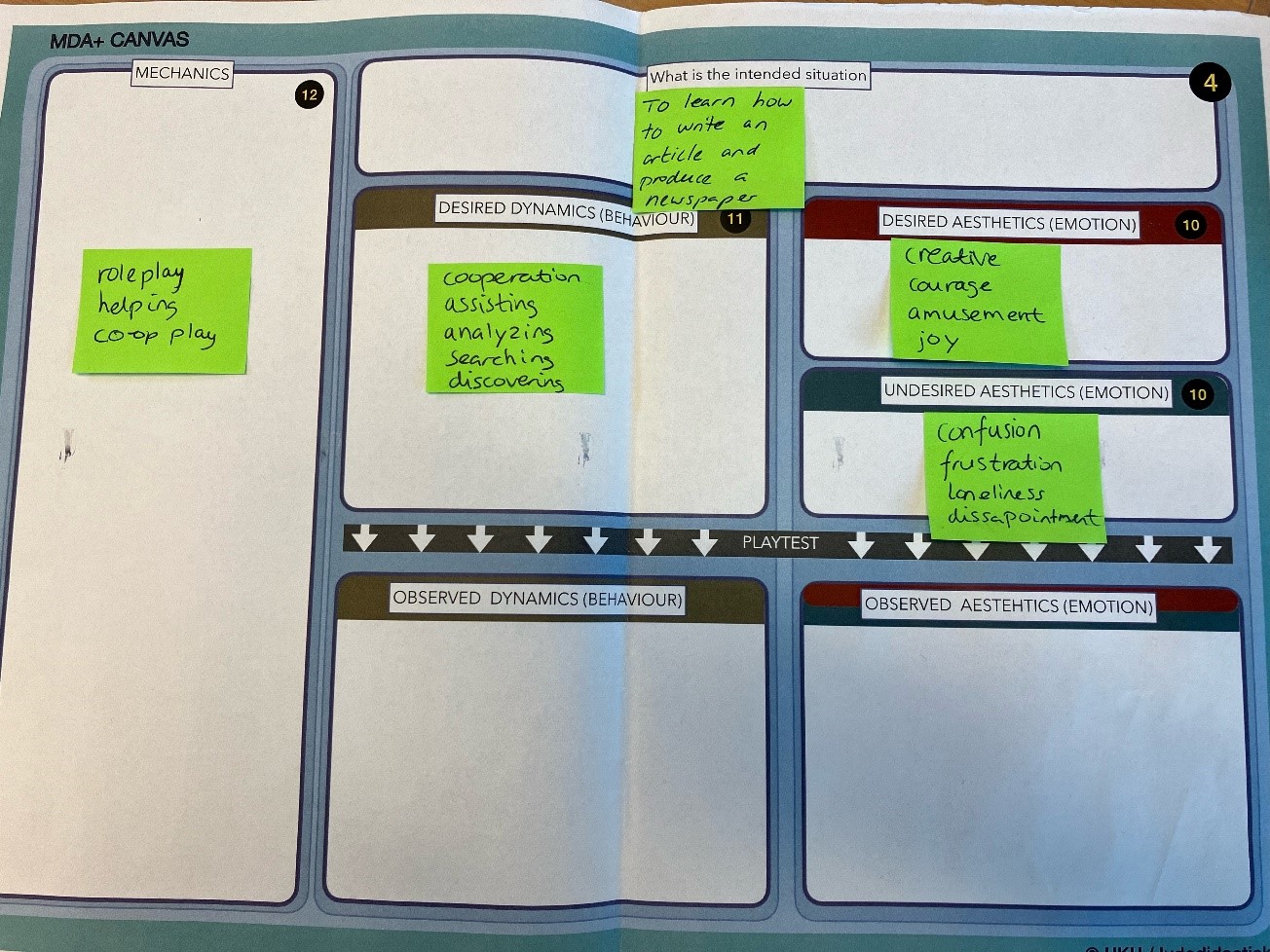Our Ludo didactic learning exprience
VUC StorstrømBy Eva Strømberg – Teacher- Professional Bacherlor’s degreee in Danish as second language and dyslexia
Ludo didactic in VUC Storstrøm
Learning experience – VUC Storstrøm
The anticipation for the first meeting was high. New learning theory is exciting and at VUC Storstrøm, we have been working with game-based learning and gamification, so it was interesting to become acquainted with ludo didactic as a new theory. However, the first meeting led to some frustration, as the expectation was for a new learning theory, but later in the process, it became clear that ludo didactic is a method that can be used in the daily planning of teaching sessions.
The method is based on 3 main cornerstones: game design, didactics, and design process. The method is rooted in design thinking, and the goal is to activate the students to be co-creators and active in their learning process. There is a focus on the students’ emotions before and after a session, making evaluation also play an important role. The idea is to continuously adjust and adapt the session according to the student group.
For the planning of teaching sessions, a template called canvas is used, focusing on the learning objective, desired aesthetics, desired dynamics, undesired aesthetics, mechanics, observed aesthetics, and dynamics. Ludo didactics is about designing learning situations based on game principles, not a new theory but a method to rethink your lesson plan.
My learning experience is based on a group of students, all of whom have Danish as their second language. They are enrolled at the lower secondary education level. The age range is from approximately 25 years to 40 years.
The first time the course was conducted over 3 days, totaling 9 lessons with 8 students – without a teacher.
The second time it was conducted in one day, totaling 6 lessons with 6 students – with a teacher.
The teaching course was designed based on an MDA+ CANVA.
The teaching process was as follows:
The group was supposed to imagine themselves as a newspaper editorial team, where each member had to fulfill specific roles. They decided themselves who would take on the predefined roles provided by the teacher. A chief editor at both locations, being taught simultaneously. Journalists at both locations as well as layout designers at both places. The group had to figure out how to distribute the tasks themselves. The end product was supposed to be a newspaper front page with a minimum of 1 news article, 1 background article, and 1 reader’s letter.
Evaluation of the first course with 8 students without a teacher:
Since I was not present during the process, it was not possible to observe the students’ emotions and behavior. They were asked to fill out an evaluation form where they had to describe their feelings on the first day, the second day, and the last day. As the students have Danish as a second language, I had translated the negative and positive words in the canvas model (appendix) from English to Danish, so that the students did not have to spend time finding the words but could choose the ones that matched their feelings.
The form looked like this:
|
What emotions did I have Monday? |
What emotions did I have Wednesday, during the process? |
What emotions did I have Thursday at the end of the process? |
|
|
|
|
In summary, there is a consensus that on the first day, everyone is excited about the task. Words like anticipation, energetic, hope, joy, trust, desire and courage are used.
On the second day, which is in the middle of the process, words like loneliness, surprised, relaxed, confused, nervous, reluctance, sorrowful, desperate, support, and hope are used.
On the last day, when the task is completed and the product should be finished, words like relaxed, relief, frustrated, dissatisfied, disappointment, energy, dreaming, and creative are used.
They all agreed that it would have been good if the teacher had been present so that the groups could be guided along the way.
Evaluation of the second course with 6 students and a teacher:
The course lasted for one day, so the questions on the evaluation sheet were as follows:
|
What emotions did I have when I started? |
What emotions did I have while we were working? |
What emotions did I have when we were finished? |
|
|
|
|
In summary, there is an agreement that the day starts with a positive expectation. Words like trust, creative, energy, surprised, and hope are used.
Words describing feelings while working are: inspiration, desire, energy, uncertainty, nervousness.
Words describing feelings when they were finished: hope, relaxed, relief, frustration. Frustration and embarrassment over the result not meeting expectations.
The group had some difficulties with collaboration, so they learned a lot about their own expectations and ambitions in relation to group work. It was enlightening to articulate their feelings.
Profile of the trainer in this learning experience:
The teaching process is based on the constructivist learning theory, where learning takes place in a collaborative problem-solving environment where students become active participants in their own learning (Karttunen/Koskela 2023). In such a teaching process, the role of the teacher is that of a facilitator.
Both courses were conducted in the same manner, with two different groups of students, one with the teacher as a facilitator and the other without a teacher present.
It was interesting to discover the students’ need for a teacher to lean on during the process. Even though the student groups are adult learners, there is still a need for a teacher who can guide and provide support throughout the process.
The first course was conducted without the presence of the teacher, which was reflected in the evaluation, as many responses were similar in terms of initial enthusiasm turning into frustration during the course.
The second course also started with interest and enthusiasm, but quickly in the process, there was a need for the teacher’s help to guide and assist in distributing the task in a suitable manner, so that the flow in the process could be restored. In this course, evaluation could be done on “observed aesthetics” and “observed dynamics” from MDA+Canva.
|
|
Before the teachers guidance |
After the teachers guidance |
|
Observed aesthetics (emotion) |
fascination, joy, confidence, confusion, frustration, distress |
courage, creative, confidence, satisfaction |
|
Observed dynamics (behavior) |
listening, helping, cooperating, dominating, avoiding, |
searching, helping, cooperating, relief |
Conclusion: When organizing a teaching process based on the ludodidactic method, students will become more engaged in the task. There will be a focus on collaboration and initiative. The teacher’s role is that of a facilitator of the learning process, who can “create a positive, stimulating, and safe environment for the participants, encourage participation and interaction, manage conflicts and disagreements, and deal with difficult or disruptive behaviors” (Karttunen/Koskela 2023)


